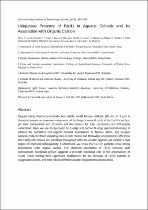 ResearchSpace
ResearchSpace
Ubiquitous presence of Fe(II) in aquatic colloids and its association with organic carbon
JavaScript is disabled for your browser. Some features of this site may not work without it.
- ResearchSpace
- →
- Research Publications/Outputs
- →
- Journal Articles
- →
- View Item
| dc.contributor.author |
von der Heyden, BP

|
|
| dc.contributor.author |
Hauser, EJ

|
|
| dc.contributor.author |
Mishra, B

|
|
| dc.contributor.author |
Martinez, GA

|
|
| dc.contributor.author |
Bowie, AR

|
|
| dc.contributor.author |
Tyliszczak, T

|
|
| dc.contributor.author |
Mtshali, Thato N

|
|
| dc.contributor.author |
Roychoudhury, AN

|
|
| dc.contributor.author |
Myneni, SBC

|
|
| dc.date.accessioned | 2016-07-20T11:10:19Z | |
| dc.date.available | 2016-07-20T11:10:19Z | |
| dc.date.issued | 2014-08 | |
| dc.identifier.citation | von der Heyden, B.P. Hauser, E.J. Mishra, B. Martinez, G.A. Bowie, A.R. Tyliszczak, T. Mtshali, T.N. Roychoudhury, A.N. and Myneni, S.B.C. 2014. Ubiquitous presence of Fe(II) in aquatic colloids and its association with organic carbon. Environmental Science & Technology Letters, 1(10), 387-392 | en_US |
| dc.identifier.issn | 2328-8930 | |
| dc.identifier.uri | http://pubs.acs.org/doi/pdf/10.1021/ez500164v | |
| dc.identifier.uri | http://hdl.handle.net/10204/8676 | |
| dc.description | Copyright: 2014 American Chemical Society. Due to copyright restrictions, the attached PDF file only contains the abstract of the full text item. For access to the full text item, please consult the publisher's website. The definitive version of the work is published in Environmental Science & Technology Letters, 1(10), 387-392 | en_US |
| dc.description.abstract | Despite being thermodynamically less stable, small ferrous colloids (60 nm to 3 µm in diameter) remain an important component of the biogeochemical cycle at the Earth’s surface, yet their composition and structure and the reasons for their persistence are still poorly understood. Here we use X-ray-based Fe L-edge and carbon K-edge spectromicroscopy to address the speciation and organic–mineral associations of ferrous, ferric, and Fe-poor particles collected from sampling sites in both marine and freshwater environments. We show that Fe(II)-rich phases are prevalent throughout different aquatic regimes yet exhibit a high degree of chemical heterogeneity. Furthermore, we show that Fe-rich particles show strong associations with organic carbon. The observed association of Fe(II) particles with carboxamide functional groups suggests a possible microbial role in the preservation of Fe(II). These finding have significant implications for the behavior of Fe(II) colloids in oxygenated waters, and their role in different aquatic biogeochemical processes. | en_US |
| dc.language.iso | en | en_US |
| dc.publisher | American Chemical Society | en_US |
| dc.relation.ispartofseries | Workflow;17218 | |
| dc.subject | Aquatic colloids | en_US |
| dc.subject | Fe(II) | en_US |
| dc.subject | Iron | en_US |
| dc.subject | Organic carbon | en_US |
| dc.title | Ubiquitous presence of Fe(II) in aquatic colloids and its association with organic carbon | en_US |
| dc.type | Article | en_US |
| dc.identifier.apacitation | von der Heyden, B., Hauser, E., Mishra, B., Martinez, G., Bowie, A., Tyliszczak, T., ... Myneni, S. (2014). Ubiquitous presence of Fe(II) in aquatic colloids and its association with organic carbon. http://hdl.handle.net/10204/8676 | en_ZA |
| dc.identifier.chicagocitation | von der Heyden, BP, EJ Hauser, B Mishra, GA Martinez, AR Bowie, T Tyliszczak, Thato N Mtshali, AN Roychoudhury, and SBC Myneni "Ubiquitous presence of Fe(II) in aquatic colloids and its association with organic carbon." (2014) http://hdl.handle.net/10204/8676 | en_ZA |
| dc.identifier.vancouvercitation | von der Heyden B, Hauser E, Mishra B, Martinez G, Bowie A, Tyliszczak T, et al. Ubiquitous presence of Fe(II) in aquatic colloids and its association with organic carbon. 2014; http://hdl.handle.net/10204/8676. | en_ZA |
| dc.identifier.ris | TY - Article AU - von der Heyden, BP AU - Hauser, EJ AU - Mishra, B AU - Martinez, GA AU - Bowie, AR AU - Tyliszczak, T AU - Mtshali, Thato N AU - Roychoudhury, AN AU - Myneni, SBC AB - Despite being thermodynamically less stable, small ferrous colloids (60 nm to 3 µm in diameter) remain an important component of the biogeochemical cycle at the Earth’s surface, yet their composition and structure and the reasons for their persistence are still poorly understood. Here we use X-ray-based Fe L-edge and carbon K-edge spectromicroscopy to address the speciation and organic–mineral associations of ferrous, ferric, and Fe-poor particles collected from sampling sites in both marine and freshwater environments. We show that Fe(II)-rich phases are prevalent throughout different aquatic regimes yet exhibit a high degree of chemical heterogeneity. Furthermore, we show that Fe-rich particles show strong associations with organic carbon. The observed association of Fe(II) particles with carboxamide functional groups suggests a possible microbial role in the preservation of Fe(II). These finding have significant implications for the behavior of Fe(II) colloids in oxygenated waters, and their role in different aquatic biogeochemical processes. DA - 2014-08 DB - ResearchSpace DP - CSIR KW - Aquatic colloids KW - Fe(II) KW - Iron KW - Organic carbon LK - https://researchspace.csir.co.za PY - 2014 SM - 2328-8930 T1 - Ubiquitous presence of Fe(II) in aquatic colloids and its association with organic carbon TI - Ubiquitous presence of Fe(II) in aquatic colloids and its association with organic carbon UR - http://hdl.handle.net/10204/8676 ER - | en_ZA |





